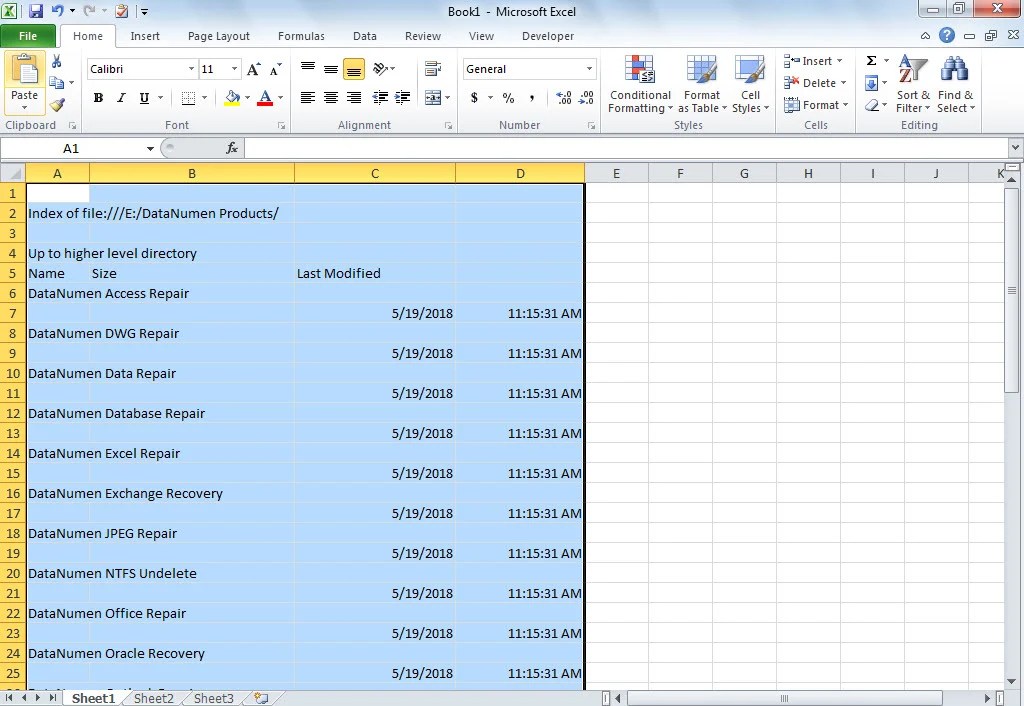Discover All Excel Sheet Names with Ease

Excel is a powerful tool widely used across numerous industries for organizing, analyzing, and storing data in spreadsheets. One often overlooked feature is the ability to manage multiple sheets within a workbook, especially when dealing with large datasets or projects that require segmentation. In this comprehensive guide, we'll explore various methods to effortlessly list all sheet names in Excel, optimizing your spreadsheet navigation and management for seamless workflow.
Understanding Excel Workbooks


Before diving into the methods to list sheet names, it’s beneficial to understand Excel workbooks:
- Workbook: An Excel file that contains one or more worksheets.
- Worksheet: A sheet within a workbook where you enter and manage data.
- Sheet Tabs: Located at the bottom of Excel, these allow you to switch between worksheets.
Method 1: Manual Approach

The simplest way to see all the sheet names in an Excel workbook is:
- Right-click on the navigation button at the bottom left of Excel, next to the sheet tabs.
- From the menu that appears, select ‘Unhide’. Here, you’ll see a list of all hidden sheets, but you’ll also find a list of all sheets when you click on ‘Cancel’ or ‘OK’ if no sheets are hidden.
📝 Note: This method does not provide an automated list, but it helps in visualizing the sheet structure.
Method 2: Using Excel VBA

For those familiar with Excel’s VBA (Visual Basic for Applications), scripting can provide a dynamic solution:
Sub ListSheetNames()
Dim ws As Worksheet
Dim sheetList As Range
Set sheetList = Worksheets(1).Range("A1")
For Each ws In ActiveWorkbook.Worksheets
sheetList.Value = ws.Name
Set sheetList = sheetList.Offset(1, 0)
Next ws
End Sub
- Open the Excel workbook where you want to list the sheets.
- Press Alt + F11 to open the VBA editor.
- Insert a new module and paste the above code.
- Run the 'ListSheetNames' macro from the list of macros to have Excel list the names in the first sheet's column A.
Method 3: Excel Formula Approach

If you prefer avoiding macros, Excel provides a formula-based approach:
| Cell | Formula |
|---|---|
| A1 | =RIGHT(GET.WORKBOOK(1),LEN(GET.WORKBOOK(1))-FIND(“]”,GET.WORKBOOK(1))) |
| A2 | =IF(ROW()=ROW(),IF(OR(LEFT(A1)=“”,A1=“”),“”,GET.WORKBOOK(1,ROW(A1)+1)),“”) |

📝 Note: The formula above lists all sheet names starting from cell A1. Use Ctrl + Shift + Enter to enter this as an array formula.
Method 4: Using Power Query

Power Query, Excel’s data transformation tool, can list all workbook sheets:
- Go to the Data tab, then select Get Data > From Other Sources > Blank Query.
- In the Formula Bar, enter:
let
Source = Excel.Workbook(File.Contents(“C:\Path\To\Your\Workbook.xlsx”), null, true),
Sheets = Source[Sheets],
AllSheets = Sheets[Data]
in
AllSheets
Comparison of Methods

Here’s a quick overview of the methods:
| Method | Complexity | Requires VBA? | Provides Output |
|---|---|---|---|
| Manual | Simple | No | Visual only |
| VBA Scripting | Intermediate | Yes | List on a sheet |
| Excel Formulas | Advanced | No | List on a sheet |
| Power Query | Intermediate | No | Query output |
The key takeaway here is that Excel offers multiple avenues to manage your data across different sheets effectively. Depending on your skill level with Excel, your preference for automation, and your willingness to dive into coding or complex formulas, there's a method that suits everyone. Each approach has its strengths, catering to different user needs for listing Excel sheet names:
- The manual approach provides a quick visual check of your workbook structure, which is sufficient for occasional needs.
- VBA scripting is ideal for those needing to perform this task frequently or as part of a larger automated process.
- Excel formulas offer a no-coding solution for listing sheet names, although they require some knowledge of array formulas.
- Power Query provides a dynamic way to list sheet names, which is particularly useful if you also need to analyze or transform data from these sheets.
📝 Note: Always remember to save your workbook or export the results to maintain the list of sheet names if they might change over time.
Can I list hidden sheet names in Excel?

+
Yes, all methods listed here will include hidden sheets in the output. VBA, Excel formulas, and Power Query will all display hidden sheet names, allowing you to manage or reference them as needed.
What if the sheet name contains spaces?

+
When using VBA or formulas, sheet names with spaces are handled automatically. However, if you’re manually manipulating sheet names or referencing them in formulas, remember to use single quotes around the sheet names like this: ‘Sheet Name’.
Can these methods be applied to Excel Online?

+
Excel Online does not support VBA scripting, but it does allow Power Query through Power Apps, and some Excel functions work similarly in online and desktop versions, allowing you to use formulas to list sheet names.
What are the limitations of the methods described?

+
Manual methods are limited by the need to visually inspect sheet names. VBA requires some programming knowledge. Excel formulas can be complex and might not work in all Excel versions or online. Power Query requires familiarity with its interface and might not be available in all Excel environments.